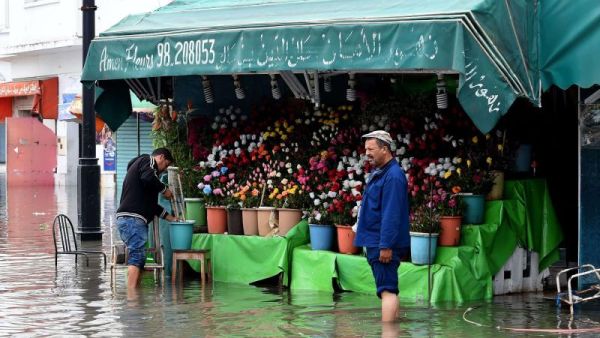Torrential rainfall that swept across Tunisia, including greater Tunis, earlier this week revealed the fragile state and poor maintenance of the country’s infrastructure, a failure blamed on the country’s ministry of equipment, housing and territorial development.
Over the years, Tunisians have grown familiar with shocking scenes of flooded streets and dilapidated infrastructure during the cold, rainy winter months.
Deadly infrastructure
As heavy rain battered the country, a young woman in her twenties, employed in the industrial zone of Enfidha, died Monday after falling into a sewer, said the regional director of Civil Protection of Sousse, Colonel Jalloul Jaballah.
The victim, later identified as Maryam Dhahbi, fell into a manhole after leaving her job and was found 300 meters away from where she disappeared. The young woman died of cardiac arrest before arriving at the hospital, Jaballah said.
A day after the incident, the head of the municipality of Enfidha Abdallatif Hammouda attempted to skirt responsibility, blaming the ministry of equipment for the accident.
Hammouda added that the municipality’s task is only to warn the equipment ministry’s units to carry out the necessary maintenance work, and said that it had issued such alerts on several occasions.
He denied that the victim fell into a sewer as was reported; stressing that she fell into a stream that pushed her towards a water drainage pipe.
Hammouda even seemed to cast blame on the victim herself, saying she had engaged in dangerous behaviour by rushing to try and find transportation back home in the poor weather, which caused her to fall into the water.
Dhahbi is not the first to fall victim to Tunisia’s poor infrastructure. Earlier in October, a 10-year-old girl died in Bhar Lazrag after falling into a manhole covered by a plywood slab. The general manager of the national sanitation company pledged the day of the incident that no manhole will be left uncovered. All over Tunis and its suburbs, uncovered or improperly-covered manholes remain a public hazard.
Ongoing neglect
The flooding, as well as excess waste swept up by the rivers, is increasingly frequent in Tunisia, especially in poorer, crowded neighbourhoods that are largely neglected by the government.
Such neglect is evident at a cemetery on the border of Ettadhamen-Mnihla, which is surrounded by some of the capital’s poorest areas, such as districts 106 and 105, Cite Errafaha and Douar Hicher.
Following the recent heavy rain, the cemetery, supposedly a place of calm and peace, turned into a drop-off point for all kinds of waste.
In 2011, when an uprising erupted against the former regime of late President Zine El Abidine Ben Ali, many poorer neighbourhoods, notably Ettadhamen, that were at the forefront of the movement paid a heavy human and material price for their protests against mismanagement, corruption and marginalisation.
During election season, politicians often scramble to win the votes of these areas’ inhabitants with lofty promises of development, but they usually go unfulfilled.
Affecting the rich and poor
Elsewhere in greater Tunis, entire neighbourhoods were submerged in water, including houses, schools, post offices, police stations, metro stations and train, with scenes of cars caught in the mud captured by citizens and shared on social media.
On Sunday, 80mm of rain was enough to engulf certain areas in and around the capital city in a few hours, causing significant damage to public and private property.
Photos shared by internet users also showed heavy traffic, with some people stuck in their cars submerged in water.
In the city of Ariana, a suburb of the capital, roads, schools and homes were hit hard by the rainfall, with locals noting that only a few rain showers are enough to reveal the extent of the country’s failing infrastructure.
In Ariana, the problem affected all neighbourhoods – rich and poor.
From the poorest districts in Ennassim, to the relatively wealthy cities of New Ariana, to the middle class areas in the city of Ennozha and Ariana Ville, damage impacted local communities, which largely blamed authorities for failing to maintain the areas.
“This is not the first time. Every winter, we witness the same scenes and every time there is rain, we fear for ourselves and our children,” said a petrol worker in New Ariana.
“The municipality is absent. The authorities are not doing their job and we are growing increasingly desperate as we don’t see the end of this tunnel,” added a 17 year-old student.
“The state has crumbled. It is unfortunately a failed state now, run by a bunch of incompetent figures who trade in populism and religion to serve their personal interests,” said the student.
Tunisian authorities have often blamed anarchic construction, the disposal of waste in evacuation canals and a lack of respect for urban development plans for the deteriorating situation.
Citizens, however, say it is mostly the state’s negligence that is exacerbating the flooding, particularly in greater Tunis.
This article has been adapted from its original source.








